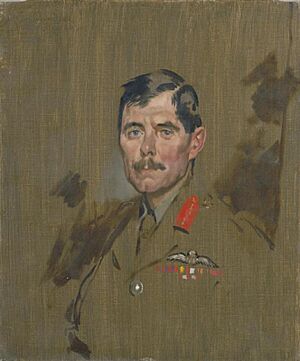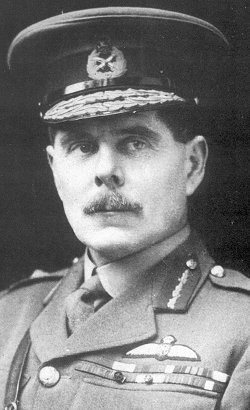Hugh Trenchard as commander of the Royal Flying Corps in France facts for kids
Hugh Trenchard led the Royal Flying Corps (RFC) in France. He was their commander from August 25, 1915, to January 2, 1918. The RFC was the air arm of the British Army during World War I.
Contents
Becoming a Leader: Trenchard's Command Style
In the summer of 1915, General Sir David Henderson felt the RFC needed a strong leader. This person had to understand military flying and have recent war experience. Henderson chose Trenchard for this important role. On August 25, 1915, Trenchard became a brigadier-general. He was put in charge of the RFC's operations in the field.
Trenchard was very hands-on as a commander. He paid close attention to the details of his squadrons' work. He made sure the RFC's training was strict and effective. He also worked hard to get enough supplies for his airmen. Trenchard wanted his pilots to be brave and aggressive in the air. His assistant, Maurice Baring, helped him a lot during this time.
Early Challenges: Loos, Fokker Scourge, and Verdun
In September 1915, Trenchard guided the RFC during the Battle of Loos. The RFC helped the army by spotting enemy positions for artillery. They also used early wireless radios to send information from the air. This battle was also important for another reason. It was the first time the RFC successfully bombed enemy targets from the air.
By late 1915, the RFC faced a new problem called the "Fokker Scourge". German Fokker planes had a special device. It let their machine guns fire through the spinning propeller blades. This made them much more dangerous than British planes. Trenchard found it hard to keep control of the skies. The RFC lost many planes, partly because Trenchard insisted on attacking the enemy.
Even though German planes were better, Trenchard made changes. British planes got new Lewis guns. By early 1916, the RFC received newer, better fighter planes. This helped them fight the Fokkers on more equal terms. In December 1915, General Haig became the new commander of the British Expeditionary Force. Trenchard and Haig worked together again, this time at a higher level.
During the Battle of Verdun in 1916, Trenchard helped the French Air Service. He sent them Lewis guns, bullets, and bombsights. Later in the battle, the French air force became more aggressive, partly because of Trenchard's influence. In March, Trenchard was promoted to major-general as the RFC grew larger.
Major Battles: Somme, Bloody April, and Arras
Before the Battle of the Somme, Trenchard ordered his pilots to fly reconnaissance missions. They also targeted German observation balloons. When the battle began, Trenchard had 105 aircraft ready. His squadrons joined the fight systematically. Many planes flew low to bomb enemy positions, and many were shot down.
Despite heavy losses, the RFC gained control of the skies over the Somme by mid-August. However, by September 1916, Trenchard worried about the RFC's strength. He asked for more planes from the War Office and even the Navy. But replacements were slow to arrive. By mid-September, the German Air Service grew stronger. The RFC started losing more planes. This made it harder for them to help the army with artillery spotting.
After the Battle of the Somme, the RFC remained weak. Trenchard's planes were still fighting the Germans all along the Front. In November 1916, Haig, urged by Trenchard, asked for 20 more fighter squadrons. Trenchard even went to London in December to ask for planes himself. When his requests didn't work, he wrote to officials. He even went above his boss's head to Lord Cowdray, which led to a strong warning.

The winter weather gave the air forces a break. But in March 1917, better weather brought new German air attacks. Trenchard had to reduce his offensive flights. Still, he continued to support the British soldiers as they moved towards the Hindenburg Line. In April, the RFC helped the soldiers during the Battle of Arras. They fought fierce air battles with the Germans, a period known as Bloody April. From March to May, Trenchard lost 1270 aircraft. This, combined with problems in British aircraft production, almost destroyed the RFC.
By mid-1917, William Weir's efforts to boost British aircraft production began to pay off. New planes like the S.E.5s, Bristol Fighters, and de Havilland 4s arrived. These new aircraft helped Trenchard gain control of the airspace along the Front. This was especially true before and during the Battle of Messines. Even though the RFC still had low reserves, Trenchard and his team started planning for Haig's next big attack at Ypres.
German Air Raids on London
In June 1917, German planes called Gothas bombed London. This caused a huge public outcry. Trenchard was called to meet the Prime Minister, Lloyd George. Trenchard explained the air situation and suggested what to do. Lloyd George wanted to bomb the German city of Mannheim right away. Trenchard disagreed, seeing it as just an act of revenge.
However, when he returned to France, Trenchard did start planning a strategic bombing campaign against Germany. Against his advice, two fighter squadrons were moved from the Front. They were assigned to patrol the English Channel during the day. The German Air Service took advantage of the RFC's weaker state in France. They bombed British towns, trenches, and supply depots. British army commanders then urged Trenchard to make air protection his main goal. But Trenchard refused. He was focused on bombing and scouting behind German lines for Haig's next attack.
After London was bombed a second time, the government asked General Jan Smuts to study the British air services. His report came out in August 1917. It suggested creating an independent air force with its own government department. Trenchard saw an early copy and disagreed. He believed that merging the two air services and creating a new department would cause too much disruption. He felt it would take away from the important task of fighting the Germans in the air.
From September 28 to October 1, German Gothas and Zeppelins bombed London again. The British government wanted immediate action. Trenchard was called from France once more. He arrived by plane on October 2, making an emergency landing in Lympne after his planes were mistaken for a German raid. In London, Trenchard told the government that his first bomber airfield at Ochey near Nancy was ready. Lloyd George urged that the bombing begin as soon as possible. Trenchard also used this visit to talk with Smuts about the future of the air services. Trenchard shared his worries, especially that plans for a future air force were based on unrealistic numbers for aircraft production.
Bombing German Factories
In October, British bombers arrived at Ochey. They became part of the new 41st Wing, led by Lieutenant-Colonel Cyril Newall. Preparations for bombing missions began seriously. Just six days later, de Havilland planes flew the RFC's first long-range bombing mission. They hit the Burbach iron foundry, other buildings, and railway lines. A week later, Handley Page planes from the 41st Wing conducted the first long-range night bombing raid. Bombing continued into November until winter weather stopped it.
In London, the government cared most about the propaganda value of these raids. Trenchard was praised as a great commander. Trenchard himself didn't like leading a campaign just to please politicians, even though he could choose the targets. He wanted to focus his planes on supporting the army. He didn't want to split his limited number of aircraft between two different bombing campaigns.
A New Leader for the RFC
In December 1917, Trenchard remained the commander of the Royal Flying Corps in the Field. He spent Christmas at his old headquarters in Saint-Omer. There was much talk about whether Trenchard could stay as RFC commander while also leading the new Royal Air Force (RAF). In the end, it was decided this wasn't practical. Major-General John Salmond took over Trenchard's role in France.


